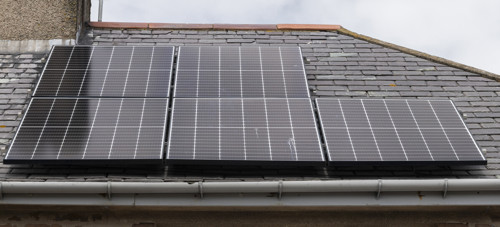Housing works
Solar panels in council homes
 Solar PV panels are devices that are mounted to your roof, and turn sunlight into free electricity for your home. They consist of cells that absorb sunlight and convert it into direct current (DC) electricity. To use this electricity in your home, an inverter is needed to convert it into alternating current (AC).
Solar PV panels are devices that are mounted to your roof, and turn sunlight into free electricity for your home. They consist of cells that absorb sunlight and convert it into direct current (DC) electricity. To use this electricity in your home, an inverter is needed to convert it into alternating current (AC).
Invertor manufacturers often provide apps for you to download that let you monitor the electricity generated. You may also have a simple device fitted in your home that shows you when the free electricity is there for you to use. Your solar panels would work best if your roofs faces south and you have no shading from tall trees or other buildings.
The amount of electricity produced depends on sunlight. You benefit most from free energy during sunny daylight hours, and more electricity will be produced in summer than in winter.
Efficient use of lighting and appliances helps save electricity even with Solar PV:
- Use high-energy appliances during the day
- Charge devices during the daylight
- Use one high-energy appliance at a time to avoid using more electricity than generated
Unlike your heating or hot water system there are no timer or on/off controls for the Solar PVs. They are on and working all the time and will generate the most electricity for your home when the sun is strongest.
Battery storage
 Domestic battery storage work with your solar panels and let you store electricity for later use, rather than it being exported back to the National Grid. The image shows how the battery storage unit looks, with outer cover removed for inspection.
Domestic battery storage work with your solar panels and let you store electricity for later use, rather than it being exported back to the National Grid. The image shows how the battery storage unit looks, with outer cover removed for inspection.
The amount of energy you can store will depend on:
- The amount of energy being generated
- Energy being used in the home
- Temperature
You will store significantly more energy in the warmer, lighter months typically between April and September. So more of your savings will be in these months than over the winter.
The batteries are affected by the temperature and as it gets colder, they are unable to take the same amount of charge from the Solar PVs. Once the temperature is below 5 degrees celsius, the battery will not charge.
If you have a battery manufactured by Alpha, it will be put into winter protection mode from mid-October to March. In this mode, the battery will not discharge below 80%, which means you won’t be able to use any stored energy below that level. Every two weeks, at 2pm on Wednesdays, the battery will automatically charge from the grid to 100%. This will use about 1 to 1.5 kWh of electricity, which you can then use in your home. If the battery is already full, the automatic charge won’t take place.
The battery is reset to summer mode in late February, when it can use its stored energy down to 11%, and no automatic top-ups are needed.
If you have a battery from a different manufacturer, these settings will not apply.
Solar energy hot water system diverter
 If you home has Solar PV, quantum heating and a hot water tank fitted then you may have a solar energy diverter installed. These devices are roughly 30cm square with an integrated display panel and you will likely find this in your electric cupboard.
If you home has Solar PV, quantum heating and a hot water tank fitted then you may have a solar energy diverter installed. These devices are roughly 30cm square with an integrated display panel and you will likely find this in your electric cupboard.
This will divert surplus energy created by the Solar PV to the top immersion heater. Energy will be diverted until the thermostat switches off, when the maximum temperature is reached in the hot water tank. This increases your use of solar energy, reducing reliance on the grid and helps you lower electricity bills. You will save more money in the sunnier months, rather than in winter, as this is when most of your Solar PV energy is generated.
Tips:
- The bottom immersion will heat your water overnight using off-peak rate electricity
- You may want to reduce the amount of off-peak water heating you do during the sunnier months
- Use the boost button on the diverter during the day so that the water in the tank is mainly heated using free energy from the Solar PV
